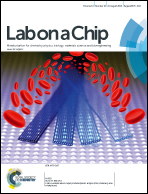Electronic control of platelet adhesion using conducting polymer microarrays
Abstract
We hereby report a method to fabricate addressable micropatterns of e-surfaces based on the conducting polymer poly(3,4-ethylenedioxythiophene) doped with the anion tosylate (PEDOT:Tos) to gain dynamic control over the spatial distribution of platelets in vitro. With thin film processing and microfabrication techniques, patterns down to 10 μm were produced to enable active regulation of platelet adhesion at high spatial resolution. Upon electronic addressing, both reduced and oxidized surfaces were created within the same device. This surface modulation dictates the conformation and/or orientation, rather than the concentration, of surface proteins, thus indirectly regulating the adhesion of platelets. The reduced electrode supported platelet adhesion, whereas the oxidized counterpart inhibited adhesion. PEDOT:Tos electrode fabrication is compatible with most of the classical patterning techniques used in printing as well as in the electronics industry. The first types of tools promise ultra-low-cost production of low-resolution (>30 μm) electrode patterns that may combine with traditional substrates and dishes used in a classical analysis setup. Platelets play a pronounced role in cardiovascular diseases and have become an important drug target in order to prevent thrombosis. This clinical path has in turn generated a need for platelet function tests to monitor and assess platelet drug efficacy. The spatial control of platelet adherence presented here could prove valuable for blood cell separation or biosensor microarrays, e.g. in diagnostic applications where platelet function is evaluated.


 Please wait while we load your content...
Please wait while we load your content...